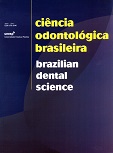Clinical attachment loss and its association with risk indicators in Brazilian adolescents and young adults
DOI:
https://doi.org/10.14295/bds.2008.v11i2.448Resumo
Purpose: This cross-sectional study aimed to determine the prevalence of periodontal clinical attachment loss in 622Brazilian adolescents and young adults (15 to 25 years) and its correlation with age, gender and smoking habits. In
addition, to evaluate the influence of different cut-off points on the prevalence data. Materials and Methods: full-mouth
periodontal examination was conducted by two trained and calibrated examiners to measure periodontal probing depth
(PPD) and clinical attachment level (CAL) at 6 sites per tooth using a manual periodontal probe. The data analysis
was performed in a subject level according to three cut-off points (CAL ≥ 1mm, 2mm or 3mm). Statistical analysis
was conducted using Wilcoxon, Student-t and Mann Whitney tests (p < 0.05). The association between age and CAL
was also analyzed by OR calculation. Results 454 subjects presented CAL of 1mm, 341 of 2mm and 251 of 3mm. In
each cut-off point it was not observed significant differences between males and females, neither between smokers and
non-smokers. Only age was associated with CAL. Subjects aged 20-25 years were 2.92 times more likely to have 2mm
of CAL than subjects 15-19 years old. Conclusions:In this young population gender and smoking habits did not show
association with CAL instead-off, age revealed an association with both presence and severity of CAL. Different cut-off
points of periodontal disease influenced prevalence data in a significant way.
Downloads
Downloads
Publicado
Como Citar
Edição
Seção
Licença
TRANSFERÊNCIA DE DIREITOS AUTORAIS E DECLARAÇÃO DE RESPONSABILIDADE
Toda a propriedade de direitos autorais do artigo "____________________________________________________________________" é transferido do autor(es) para a CIÊNCIA ODONTOLÓGICA BRASILEIRA, no caso do trabalho ser publicado. O artigo não foi publicado em outro lugar e não foi submetido simultaneamente para publicação em outra revista.
Vimos por meio deste, atestar que trabalho é original e não apresenta dados manipulados, fraude ou plágio. Fizemos contribuição científica significativa para o estudo e estamos cientes dos dados apresentados e de acordo com a versão final do artigo. Assumimos total responsabilidade pelos aspectos éticos do estudo.
Este texto deve ser impresso e assinado por todos os autores. A versão digitalizada deverá ser apresentada como arquivo suplementar durante o processo de submissão.




























